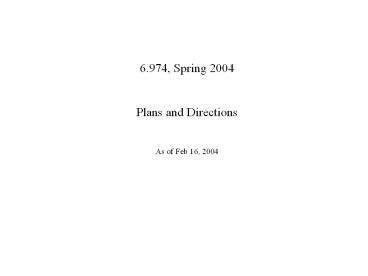6.974, Spring 2004 - PowerPoint PPT Presentation
Title:
6.974, Spring 2004
Description:
... (Ch 14) This involves all those models from above 5. Abnormal operations Unbalanced Operation Symmetrical Components (Ch 12) Faults: ... – PowerPoint PPT presentation
Number of Views:87
Avg rating:3.0/5.0
Title: 6.974, Spring 2004
1
6.974, Spring 2004 Plans and Directions As of
Feb 16, 2004
2
Here is a small power system
3
To see what is up we need to understand the
parts Generating Plants Are Connected to buses
(numbered) Lines Connect the buses (impedances
noted in ohms) Loads are noted at each loaded bus
4
Generating Plant Source
5
Buses are Connection Points
6
Each line has an impedance here in Ohms
7
Many buses are loaded, here MWjMVAR
8
Transformers connect 69 kV to 161 kV buses
9
To understand how the system works 1. Load Flow
-- how does power flow through the lines System
Representation Lines, Transformers, and
Per-unit Systems (Chs 4, 5, 9) Load Flow
Analysis (Ch 10) 2. What do generators do?
Generator representation (Ch6, 7) Dynamics
fault behavior, dynamic swings Simplified
models (voltage behind reactance 3. What do
exciters and voltage regulators do? They have
dynamics of their own. (Ch 8)
10
4. System Control generation control How
frequency is stabilized (Ch 11) Transient
stability limits to operations (Ch 14) This
involves all those models from above 5. Abnormal
operations Unbalanced Operation Symmetrical
Components (Ch 12) Faults detection and system
protection (Ch 13)
11
6. Power Systems Economics Cost of Service
Economic Dispatch (Ch 11) Deregulated System
Economics Structure of some markets
12
Project Topics (Suggestions-- I am open to
negotiation) Regulatory Lag how often should
rate cases be? Carbon Tax and Nukes can it be
made to work? DC vs. AC in vehicular systems
tradeoffs and performance Market Power and
Congestion What are ancillary services worth?
Is there a case for deregulating
transmission? Net Metering and Standby power
-- how do we pay for it? Robust Utilities vs.
Standby Generators which is best? Analysis of
the blackout of (you pick a blackout) How to
(and should we) subsidize green electrons?































